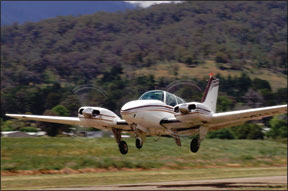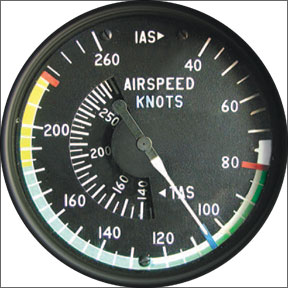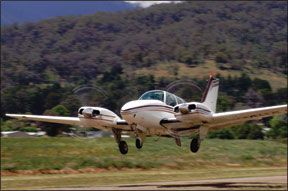Departing from a 4200-foot runway, the twin engine Beech B60 Duke lifted off after a 1500-foot takeoff roll. The landing gear was immediately retracted but at approximately 100 feet agl, a large puff of black smoke erupted from the left engine. Witnesses stated the airplane pitched up and then banked sharply to the left. At approximately 500 feet agl, the airplane banked 90 degrees to the left in a nose-down attitude, rolled inverted and impacted a building, killing the pilot and passengers.

288
It was a classic VMC rollover accident, resulting from the pilot’s failure to establish and maintain an airspeed equal to or greater than the airplane’s minimum controllable airspeed in one engine inoperative (OEI) flight. Despite the tragic loss of life, this accident provides a teaching opportunity for current or aspiring multi-engine airplane pilots, plus a reminder: Sometimes, closing the throttles and landing—even if doing so means certain airframe damage—can be preferable to trying to salvage a bad situation.
Critical
The FAA’s Airplane Flying Handbook, FAA-H-8083-3A, admonishes that the major difference between flying a light twin and a single-engine airplane is knowing how to manage if one engine loses power. Safe OEI flight requires an understanding of multi-engine aerodynamics as well as proficiency under these conditions.
One of the important concepts is understanding the “critical” engine, the one whose failure most adversely affects performance and/or handling qualities of the airplane. On twins with both engines turning clockwise when viewed from the pilot’s seat, the left engine is critical. This is because the right engine typically develops its thrust vector at a greater lateral distance from the aircraft’s center of gravity than its counterpart on the left. Failure of the left engine results in greater yaw than if the right engine failed and the left one continued operating, and demands more rudder deflection to maintain aircraft control.
For the B60 Duke, published minimal control speed with the critical engine inoperative (VMC) is 77 KIAS. Fly any slower than VMC with the critical engine not operating, and directional control of the airplane is lost. Conventional twins with counter-rotating propellers—the left engine rotates clockwise while the right one rotates counter-clockwise—do not have a critical engine per se. Instead, both engines are equally critical. Examples of this configuration include Piper’s Seneca and Seminole, Cessna’s T303 Crusader and Beech’s Model 76 Duchess. An unmodified Beech B60 Duke does not have counter-rotating propellers.
The exact airspeed the Duke pilot attempted to maintain while pitching up during the OEI climb is unknown. In his immediate response to the failure, the pilot may have pitched up too much, causing a precipitous decrease in airspeed to less than VMC. Hindsight is 20/20, but the pilot should have pitched to maintain VYSE, represented by the blue radial on the airspeed indicator (see the image on the opposite page), which is 110 KIAS for the Duke.
A Moving Number
Like stalling speed, VMC is a “moving number” affected by several factors. These factors all result in the actual VMC to be greater than published value, which is represented by the red radial on airspeed indicator (see the image above). Unfortunately, the Duke pilot may have mistakenly climbed at near VMC, predictably losing directional control.
Two control inputs are needed to properly control the airplane during OEI flight: Appropriate rudder pressure (right rudder in this case) must be applied to counteract yawing and rolling motion while ailerons are used to establish and maintain a 2-3 degree bank toward the operating engine (also known as “raising the dead” engine). This allows the horizontal component of lift to counteract the sideslip in the direction of the failed engine.
A sideslip results in increased drag, compromising climb performance. Because witnesses to the Duke accident stated the airplane banked sharply to the left on climb out, it’s evident the pilot failed to bank the airplane slightly toward the operating engine, which increases VMC. Tests have shown VMC is highly sensitive to bank angle—it increases more than three knots per degree of bank toward the operating engine at bank angles less than five degrees.
About bank angle—two sets of bank angles are advocated by the FAA for OEI flight. The first is used to maintain directional control following failure of an engine at low speeds, such as a climb following takeoff. The FAA recommends momentarily banking at least five degrees—and no more than 10—toward the operating engine as the pitch attitude for VYSE is set.
The second bank angle helps maintain best climb performance with zero sideslip. To achieve it, bank 2-3 degrees toward the operating engine, with the inclinometer’s slip/skid ball half deflected. The more the bank into the direction of the operating engine, the greater the amount of horizontal component of lift is generated to counteract yaw produced from the operating engine’s asymmetrical thrust.
A windmilling propeller is another factor increasing VMC. Examination of the Duke wreckage revealed the left propeller (failed engine) was not feathered, presenting a large amount of parasitic drag. Because drag from a windmilling prop has a moment opposite the operating engine, VMC increases. Considering all of these factors, the Duke’s actual VMC may have been much greater than the published 77 KIAS.
Configuring For speed
The other speed with which we’re concerned in an OEI situation is VYSE, which results in the greatest gain of altitude in the shortest time during OEI flight. No other airspeed results in a higher rate of climb than VYSE. Pitching for that speed is one thing; Ensuring the airplane is properly configured and optimally flown can dramatically impact whether the expected performance is obtained. Let’s start with drag.
The so-called “drag demonstration,” a required maneuver in the FAA’s practical test standards (PTS) for the multi-engine flight instructor, provides compelling evidence to always use VYSE, and with the airplane in the optimum configuration. It requires the applicant to demonstrate the effects of various airspeeds and parasitic and induced drag configurations on climb performance while simulating failure of the critical engine. This maneuver is used by multi-engine flight instructors when training private and commercial pilots-in-training for the same reasons. The PTS for both the private and commercial multi-engine rating requires applicants to exhibit knowledge of their airplane’s engine-out climb performance in several configurations. The purpose of the drag demonstration is to show how to obtain the best climb performance during OEI flight.

288
Performance (rate of climb, or RoC) resulting from various airplane configurations is plotted in the graph on the opposite page, broken down into two sub demonstrations: The VYSE demonstration itself, where only airspeed is varied, plus one demonstrating the impact various combinations of extended landing gear, flaps and windmilling propeller flown at the same speed.
For the VYSE demonstration, zero thrust is set on the simulated inoperative critical engine by appropriately setting manifold pressure and propeller controls on the left engine. For example, for a Piper PA-44-180T Turbo Seminole, manifold pressure is set to 11.5 inches and the propeller to 2000 rpm. At the same time, power on the operating (right) engine is set to maximum, the airplane is pitched to maintain a stabilized climb at VYSE; and the reading on the VSI is recorded. Next, the airplane is pitched up to maintain a stabilized climb at 10 knots less than VYSE. By pitching up, the lift vector is inclined rearward of the flight path, resulting in increased induced drag, which compromises climb performance: a lower reading on the VSI results. Then the airplane is pitched to an attitude resulting in airspeed 10 knots greater than VYSE. The VSI displays a reduced climb rate at the higher airspeed. The highest climb rate occurs at VYSE, demonstrating the best climb performance is achieved at this speed only.
For the second demonstration, engine power settings are the same as previously stated and VYSE is maintained throughout. Instead of varying the airplane’s speed, we’ll change its parasitic drag production by deploying various combinations of landing gear and flaps, and set the propeller on the simulated inoperative engine to windmill and feathered positions. This demonstration shows how varying degrees of parasitic drag compromises rate of climb. In fact, for several combinations of landing gear and flap deployment, as well as for the windmilling propeller, a positive rate of climb cannot be achieved; a disappointing rate of descent occurs.
So what are the practical implications of the drag demonstration for the average multi-engine pilot? Answer: If loss of one engine occurs following takeoff and the decision is made to continue the flight, then best climb performance is achieved by flying at VYSE, setting maximum power on the operating engine, configuring the airplane with no unnecessary drag (landing gear and flaps up, feather propeller on inoperative engine), climbing straight ahead (no turns) and maintaining zero sideslip (bank 2-3 degrees and ½ slip/skid ball width toward operating engine). It’s unlikely the Duke’s pilot did all these things—or did them well—and it’s not surprising the airplane had negligible to no climb performance, lost directional control and crashed.
When to Raise The Gear?
When dealing with an engine failure shortly after liftoff in a twin, a primary factor determining success is the now-underpowered airplane’s climb capability. As with any airplane, climb capability results from having more power available than is required to maintain level flight. To maximize climb, of course, drag must be minimized, meaning landing gear and flaps must be retracted. But what if the engine failure occurs while the gear and flaps are still extended? What if the failed engine is the one powering the hydraulic pump, which raises and lowers the gear (thereby redefining the “critical” engine)?
As with any airplane, whether single- or multi-engine, landing gear retraction should occur only after achieving a positive rate of climb and not before a safe, straight-ahead landing on the remaining runway, overrun or clear area is impossible.. In this accident, the Duke pilot retracted the landing gear immediately after rotation even though approximately 2700 feet of runway remained. Doing so effectively eliminated the option of landing straight ahead. One method to consider—whether flying a single or a twin—is to leave the landing gear down until passing over the departure end of the runway.
The FAA recommends that if failure of an engine occurs immediately after liftoff with landing gear down, the pilot should maintain directional control, close both throttles and land straight ahead on the remaining runway or overrun, accepting possible damage but maintaining control. In the Duke accident, critical engine failure occurred at about 100 feet agl. The pilot and passengers may have survived had this recommendation been followed.
Altitude On Departure
After a normal liftoff and with all systems operating, especially in a twin-engine airplane, a major goal is to gain altitude as rapidly as possible. Altitude gain is more important than pitching to achieve excess airspeed. Altitude gives the pilot time to think and react to safely fly the airplane. When power is fixed—i.e., using full power on takeoff—pitch controls airspeed. It is important to appropriately pitch the airplane to attain best all-engine rate of climb speed with both engines operating (VY) and VYSE in the event only one engine is operating.
Whether VY or VYSE is appropriate for the situation, it should be maintained until a safe altitude is reached, considering terrain, obstructions, etc. The FAA defines the “safe single-engine maneuvering altitude” as a minimum of 400 to 500 agl. In the author’s experience as a multi-engine flight instructor for several years, a higher minimum altitude is preferable, i.e., pattern altitude or 1000 feet agl.
Responding To Failure
Knowledge of the unique aerodynamic characteristics multi-engine airplanes and proficient flying skills are keys to flight safety. The inherently precarious nature of multi-engine airplane flying requires pilots to thoroughly learn and be able to correctly perform OEI procedures, especially during takeoff and climbout. Due to the combined effects of critical engine failure, full-power right engine asymmetric thrust, and a pilot’s incorrect control input actions immediately after takeoff, a twin-engine airplane is predisposed to crashing, as in the Duke accident described at the beginning.
With loss of an engine, it is paramount to maintain airplane directional control. Immediately prior to takeoff and while holding short of the runway, it is recommended to review flight control input actions for possible engine-out scenarios; i.e., an engine failure during takeoff roll, an engine failure after takeoff with gear down and an engine failure after takeoff with gear up. This review is a final safety check of flight control input actions following loss of an engine, preparing the pilot to respond correctly and survive one engine failure after takeoff.
Dr. Michael Banner is a flight instructor at University Air Center Flight School, Gainesville, Fla., professor at the University of Florida in Gainesville and instructor pilot in the Civil Air Patrol. A CFI-I/MEI, he has some 5000 hours flight time and owns a GCBC Citabria.




